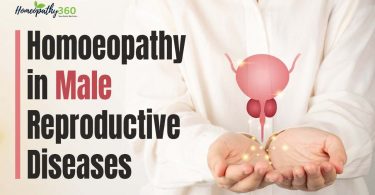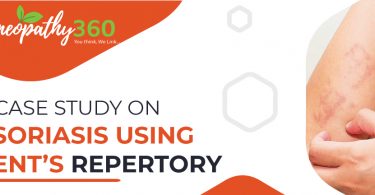
Abstract:
In the pandemic of COVID 19, many new variants and their types of infection have been seen. This case study is a discussion of about one of such infection “pneumocystic pneumonia”, a multiple cystic lung disease. There was no such experience in the beginning of treatment of the disease. Many of the things were exactly learnt like diagnosis base, treatment protocol, obstacles and required mechanical aid. On the basis of initial symptoms treatment was given, signs of improvement were seen with homoeopathic medicines but unfortunately complete recovery/restoration could not be done. After the diagnosis of the disease, work was started on a definite action plan, but the spread of infection and co-morbid disorder remained the main obstacle in the way of cure. Based on the experience gained, its main objective is to discuss the symptoms, diagnosis and homoeopathic treatment of the case in details.
Keywords: cyst, diagnosis, homoeopathy, pneumonia
Abbreviations: Pneumocystis pneumonia (PCP), pneumocystis jiroveci pneumonia (PJP), intensive care unit (ICU), computed tomography (CT), magnetic resonance imagin (MRI), acquired immunodeficiency syndrome (AIDS), human immunodeficiency virus (HIV), acute respiratory distress syndrome (ARDS), polymerase chain reaction (PCR), prescription (Rx), High-resolution CT (HRCT), real time polymerase chain reaction (RTPCR), twice a day (BID), thrice a day (TID), four times a day (QID)
Introduction:
Pneumocystic pneumonia is a very common disease in cases related to AIDS/HIV. In the decade of 1980-90, AIDS/HIV-related deaths accounted for 30-40% of the world’s deaths. It mainly targets immune suppressed diseases, so in this pandemic of covid 19, patients with systematically weak and compromised immune systems are prone to cystic development in the lungs. Pneumocystis pneumonia (PCP) is a form of pneumonia that is caused by the yeast-like fungus Pneumocystis jirovecii. It is also known as PJP, for pneumocystis jiroveci pneumonia. This fungus was first observed in 1909 but was established as a species in 1912 under the name of pneumocystic carinii. Pneumocystis jiroveci pneumonia has been a major cause of death in premature neonates and malnourished children in the 1940s-1950s.
` In the cases of pneumocystis pneumonia, mechanical add-ons such as oxygen supply, ventilator bed and some other necessary equipment support are required. Such cases are mainly dealt with in the intensive care unit (ICU). In today’s era of modern medical equipment where high resolution X-rays, CT scans and MRIs are available, it has become easy to diagnose Pneumocystis Pneumonia.
This disease of acute nature where mortality rate is very high, homoeopathic treatment can be an effective remedy for symptomatic relief and strengthening of weak immune system. Keeping in mind the exciting cause in acute disease, the selection of proper homoeopathic remedy from different systemic approach and repetition of the dose at a fixed interval in paper dose will be helpful in getting out of this acute surge.
Pneumocystis pneumonia (PCP) is a serious infection that causes swelling and fluid buildup in the lungs. The cause is a fungus called Pneumocystis jirovecii which spreads through the air in the body. It can make people with weakened immune systems very sick. It’s rare, but PCP can affect other parts of the body as well, including the lymph nodes, liver, and bone marrow.1
Pathophysiology
In these immunosuppressed individuals, the manifestations of the infection are highly variable. The disease attacks the interstitial, fibrous tissue of the lungs, with marked thickening of the alveolar septa and alveoli, leading to significant hypoxia, which can be fatal if not treated aggressively. In this situation, lactate dehydrogenase levels increase and gas exchange is compromised. Oxygen is less able to diffuse into the blood, leading to hypoxia, which along with high arterial carbon dioxide (CO2) levels, stimulates hyperventilatory effort, thereby causing dyspnea (breathlessness).2
Sign and symptoms
Early in the infection, you might not have symptoms, or they could be mild. They may include:
- Fever (It’s usually low if you have HIV and higher if other reason.)
- Dry cough or wheezing
- Shortness of breath
- Fatigue
- Chest pain or tightness when you breathe
- Chills
- Weight loss
Symptoms usually come on slowly, over several weeks, in people who have HIV. In those whose immune systems are weak for another reason, they tend to start over a few days.(1)
Complication
Pneumothorax is a well-known complication of PCP. Also, a condition similar to acute respiratory distress syndrome (ARDS) may occur in patients with severe pneumocystis pneumonia.
Diagnosis and tests
- High resolution of X-ray chest, CT-scan or MRI.
- A test called PCR (polymerase chain reaction) .
- You might also get a blood tests to check for low oxygen levels or high levels of something called beta-D glucan.(2)
Case study
An xyz patient aged 61 years/ male patient consult for homoeopathic treatment with complaint of fever with chill, malaise, headache, dry cough, and dyspnoea since 10 days. Taking allopathic treatment from somewhere.
Details:
- High grade fever (104°F) with chill every 8 hourly. Perspiration not relief in fever (100°F).
- Dry cough want to spell out that some things lodge/choke in throat.
- Continued frontal headache that’s ripe the whole temporal region.
- Sometimes feel restlessness with dyspnoea.
- Throat pain in right side. Relief by warm application/drink.
- Extreme weakness unable to stand.
- Excessive weakness after perspiration.
- Cold sweating with offensive smell.
- Ravenous hunger.
- Dry, white-coated tongue, excessive thirst.
H/O DM type II. On medication since 2003.
Family History:
Father – hypertensive (brain strokes due to hypertension).
Elder brother – diabetic and hypertensive.
General examination: Blood pressure -140/86 mmHg, Pulse-112/mint, Respiratory rate- 28/mint, Temperature- 103◦F, SpO₂- 94%
Urine- scanty with offensive smell.
Stool- Dark stools (4-5 times in a day)
Mental general:
- Very much irritable. Easily angry when not follow his order.
- Impatient for every things.(6-7days)
- Social status: no one believed on his word. Due to this, he never stayed on his promises.
- Very much worried due to financial crisis (retired person and much responsibility for daughters’ marriage and sons’ education).
Totality:
- High grade fever not relief by perspiration.
- Cough with lodging/choking sensation in throat.
- Frontal headache extended to temporal region.
- Throat pain right side.
- Excessive weakness perspiration after.
- Ravenous hunger.
- Impatient for every things
- Very much worried due to financial crisis.
Repertorisation:5
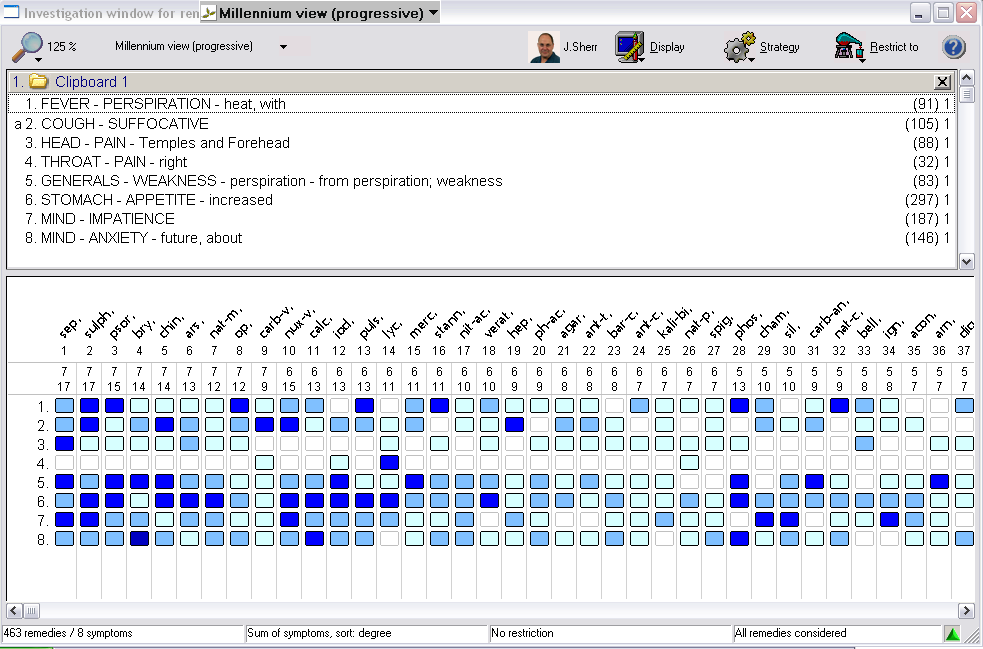
On the basis of repertorial result, Sepia was selected for prescription.
19/04/21. Rx- Sepia 1M 2 dose. For 1 days.7
Advise: COVID-19 antigen test, Complete blood count, blood sugar, C-reactive protein, Urine(routine and microscopic), X-ray chest (digital).
Prognosis : Relief in dysponea and throat pain, no other improvement.
20/04/21- COVID-19 antigen test- Negative.
Haemoglobin%- 12gm%, white blood cells- 11100/cu.mm, neutrophils-74%, lymphocytes- 23%, eosinophils- 03%, monocytes- 00%, basophils- 00%. Platelet count- 1.12 lakh/cu.mm, Erythrocyte sedimentation rate – 1st hour- 30 mm, 2nd hours- 60 mm. Blood sugar random- 267 mg/dl. Urine (R and M)- albumin- trace, sugar- +++, C-reactive protein- 76.87 mg/dl.
X-Ray finding- Changes Suggestive of parenchymal infiltration with multiple cyst seen in both lungs more on the left, mid and lower zone.- For further evaluation, suggested HRCT.
General examination: Blood pressure- 130/82 mmHg, Pulse- 104/mint, Respiratory rate- 24/mint, Temperature- 100◦F, SpO₂- 93-94%.
New totality of symptoms
- High grade fever not relief by perspiration.
- Cough with lodging/choking sensation in throat.
- Frontal headache extended to temporal region.
- Ravenous hunger.
- Impatient for every things
- Very much worried due to financial crisis.
- Diabetes
- Lungs cyst
Analysis and evaluation of symptoms:
| Sl. No. | Symptoms | Analysis | Evaluation | Miasm |
| 1 | Very much worried about financial crisis. | Mental general | 1st Grade | Sycosis |
| 2 | Impatient for every things. | Mental general | 2nd Grade | Psora |
| 3 | Lungs cyst – lung abscess | Physical geneal | 1st Grade | Syphilis |
| 4 | Diabetes in general | Physical geneal | 3rd Grade | Sycosis |
| 5 | Urine sediment sugar | Physical general | 2nd Grade | Sycosis |
| 6 | Cough croup in larynx | Physical geneal | 1st Grade | Syphilis |
| 7 | Ravenous hunger | Physical geneal | 3rd Grade | Psora |
| 8 | Pain forehead extended to temporal region | Particular | 2nd Grade | Psora |
| 9 | Fever not relief after perspiration | Particular | 3rd Grade | Psora |
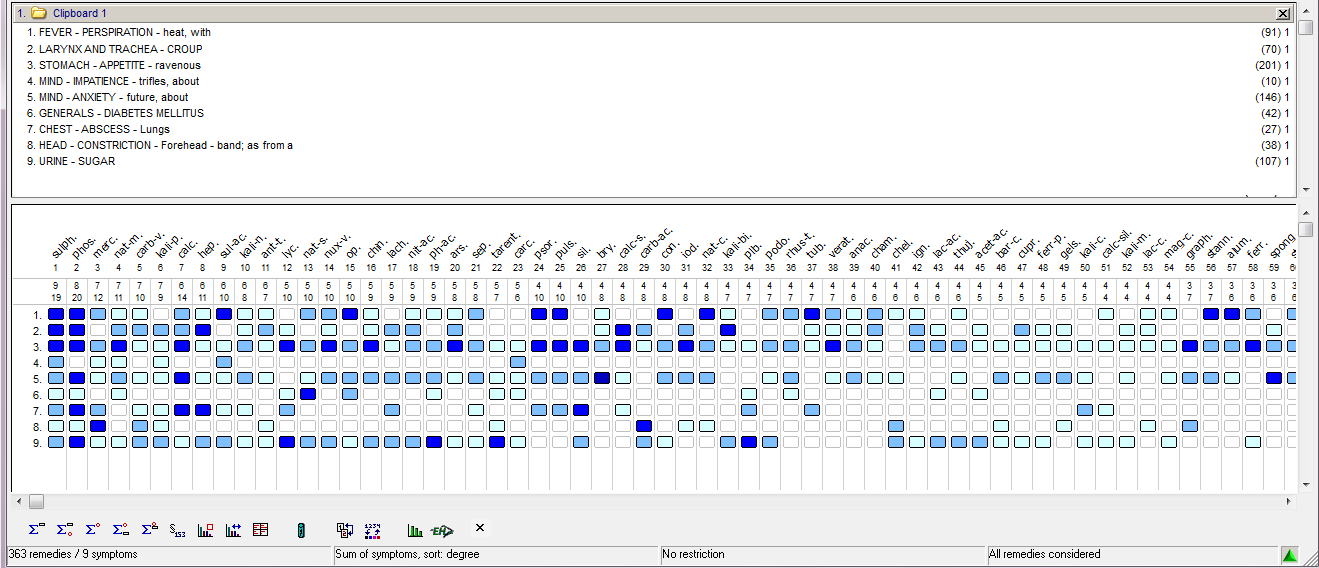
5
Selection of remedy:
On the basis of new repertorial analysis and therapeutic of pneumonia ‘Phosphorus’ selected as indicated remedy. (Reference also from theory of acute- dullness+chilly+thirsty) Dose 200 selected due to Acuteness of disease and frequent repetition required.(7,8)
20/04/21- Phosphorus 200 repetition dose twice a day (7,8), and placebo for 4 times a day. Admitted in hospital for oxygen supplement and vital monitoring. (Under observation of qualified physician)
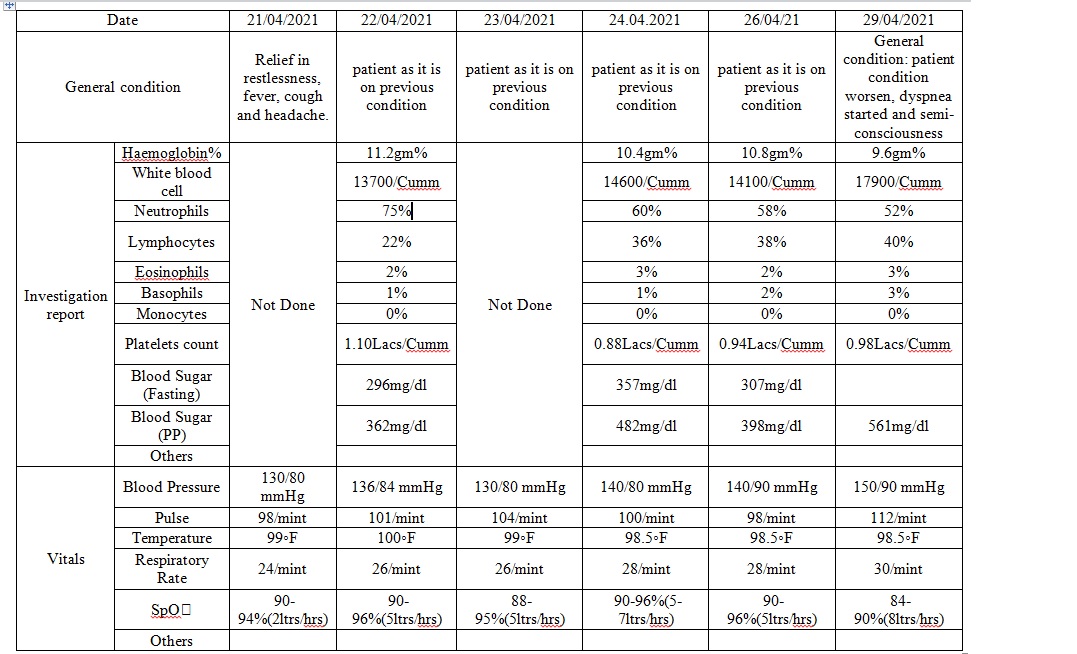
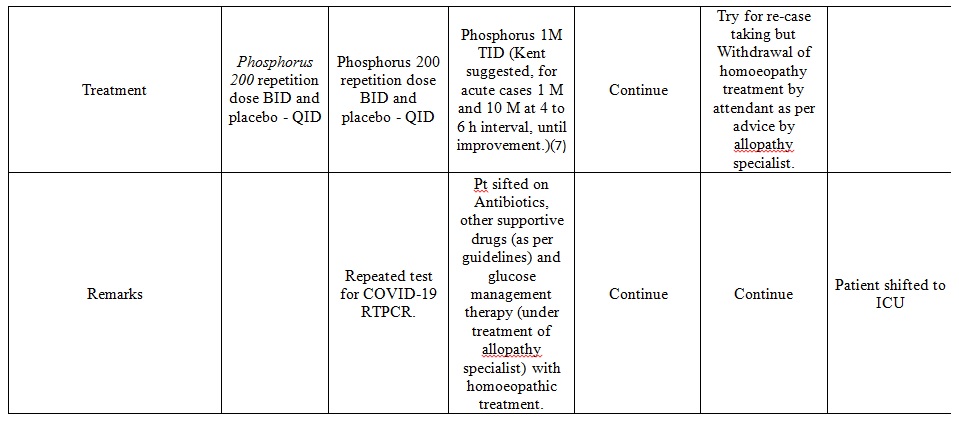
Discussion:
After the situation the question arises once again. (15 missing links of modern medicine)
- Can homoeopathy work in critical states and cover up the vitality to recover the health?
- Which symptoms should be taken and used in the assessment of the critically ill patient?
- How can information be obtained from a patient who is unconscious or in an altered state of consciousness?
- What parameters should be used to evaluate response to therapeutic homoeopathy in this case?
- Is it possible to reconcile individualised homoeopathic therapy with conventional therapy?
Approach of treatment in acute and critical cases.
Hahnemann approach: In § 72 and 73 of Organon of medicine, Dr Hahnemann classified acute diseases by categories, emphasizing the significance of exciting causes with the ability to trigger an acute process such a ‘‘transient explosion of latent psora’’. He also referred to acute diseases caused by exiting factors, which can affect a large number of susceptible individuals in a similar way (epidemic), and acute miasms, that always return in the same form.(4)
- Clinical approach in critical acute cases: The acute disease is characterized by the symptoms having a rapid onset. In many cases there may not be many peculiar symptoms other than the disease symptoms to select a similimum or there may not be much time for a detailed case taking. In such cases, while taking the case, one has to give importance to the observation, objective signs or symptoms and any keynotes besides the major symptoms. Try to find the causation which would definitely help you in the prescription. Aetiology or pathological changes has formed a very important factor in the selection of homoeopathic remedy. Causation is one of the elements of symptoms, which when strong and genuine, is of much benefit in the remedial diagnosis. In the homoeopathic repertories, there are specific rubrics for specific causations.(3)
- Use of intercurrent prescriptions: In the introduction of “The Theory of Chronic diseases” first edition, 1828 Dr Hahnemann presented the method of using acute and chronic incurrent remedies. Depending on the expression in a particular individual, the respective miasm could be diagnosed and treated with an appropriate anti-miasmatic remedy so as to achieve cure or open up the concealed diseases picture that may give new clues for selection of remedy. Constitutional prescribing is also aimed at eventual cure of the patient, not just suppression or relief of immediate symptoms.(6)
Conclusion:
In homoeopathy the best way of prescription is based on similia principle. But many of the times when the patient is in critical state, the various aspect need to be studied, clarified and improved in the proposed approach to homoeopathic treatment. As the known fact of modern medical science with bio-medical technique has set a standard parameter and the association may enhance the response to homoeopathic treatment with a surge of critical cases.
Bibliography:
- pneumonia. December 18, 2019. https://www.webmd.com/hiv-aids/guide/aids-hiv-opportunistic-infections-pneumocystis-pcp-pneumonia.
- pneumonia. 2021. https://en.wikipedia.org/wiki/Pneumocystis_pneumonia.
- Dec 17, 2015. https://www.nhp.gov.in/Principles-of-Prescribing_mtl.
- 5. Radar Synthesis Computer Repertory, Version 10; London: Archibel Homoeopathic Software.
- The Chronic Diseases, Their Peculiar Nature and Their Homoeopathic Cure New Delhi: B. Jain Publishers Pvt. Ltd., 2009.
- 7. Kent J. T. lectures on homoeopathic philosophy, New Delhi: B. Jain Publishers Pvt. Ltd., 2004.P 221,227,231
About Author:
DR MITHILESH CHANDRA SURI, MD(Hom.)
Associate Professor and HOD (Dept. of Pathology and Microbiology)
Govt. Homoeopathic Medical College and Hospital, Paraspani, Godda, Jharkhand-814147



